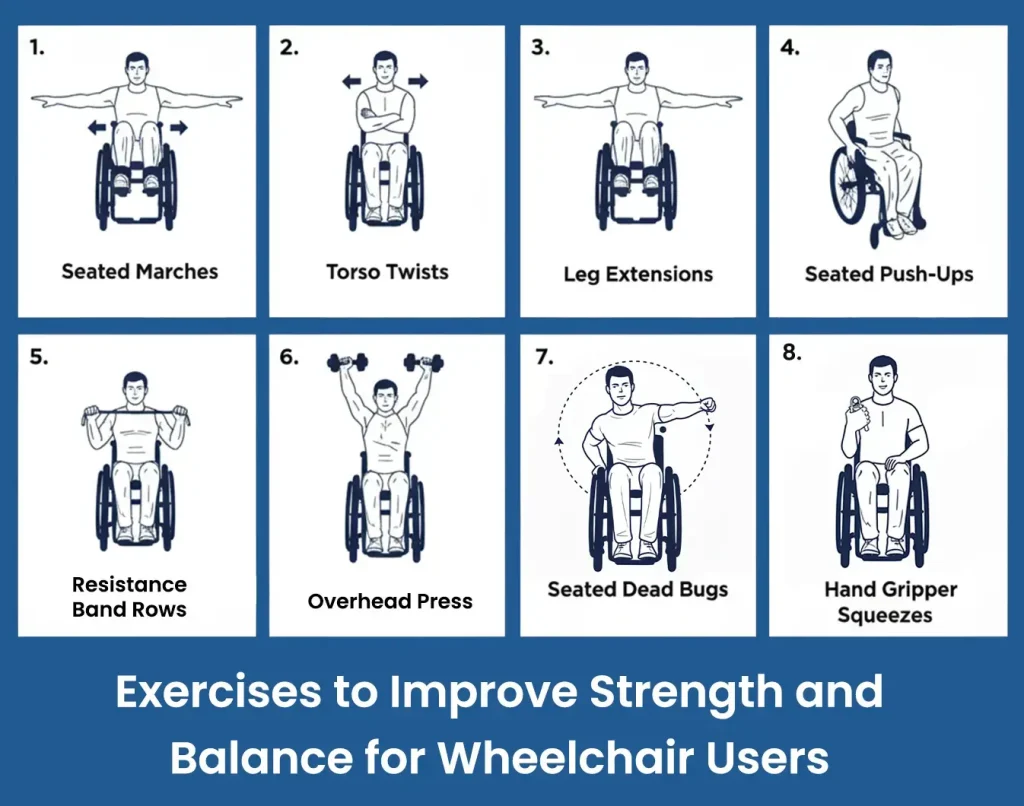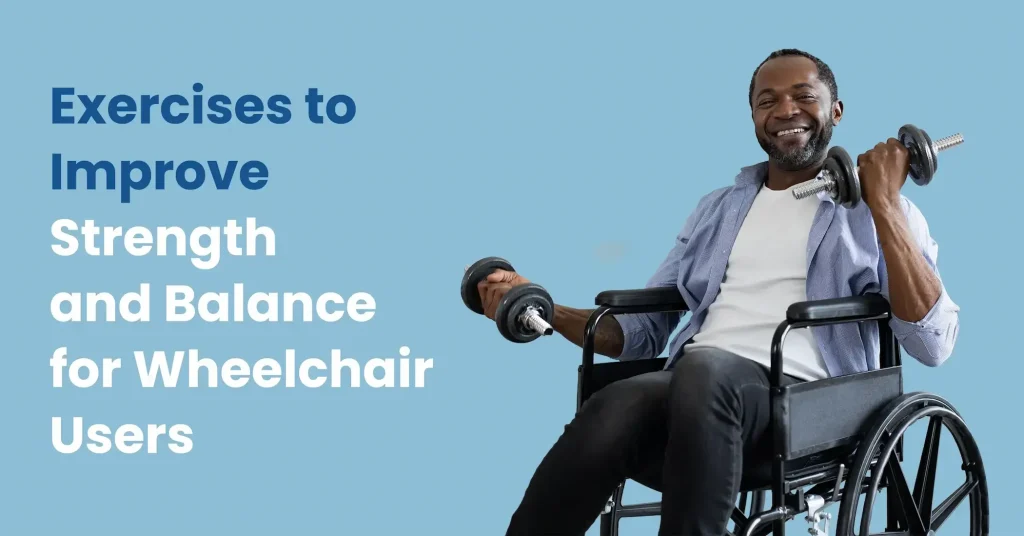Staying active is very important to maintain a healthy life. For wheelchair users exercises hold particular value. It builds functional strength and stability. It also fosters greater independence. You can achieve remarkable fitness results from a seated position. This guide offers practical seated workouts. These movements are designed to improve mobility. They will also boost your confidence.
Your safety and recovery must be considered first. Always consult your doctor for better decision. A physical therapist can advise you better than someone else. Don’t forget to lock your wheelchair. Choose a stable surface. Be impulsive to your body. Never ignore pain in any way. Consistent effort gives the best outcomes.
Why Core Strength Matters
Your core is your body’s anchor. It includes muscles in your abdomen. It also involves your back and sides. A strong core is fundamental for balance. It supports an upright posture. It makes propelling your chair more efficient. Also, assists with daily tasks like reaching. These exercises build that vital foundation.
Effective Seated Workouts for Strength
You need minimal equipment for these routines. Many exercises use just your body weight. Resistance bands and light weights are helpful. They add variety and challenge. Let us explore some potent movements.
Seated Marches
This exercise serves as an ideal warm-up. It activates your core & hip flexors. Sit straight while relaxing your shoulders. Lift-up your right knee gently. Lower it back down with control. Then lift your left knee in response. Alternate legs in a steady rhythm. Aim for twenty marches in total. Maintain smooth breathing throughout.
Torso Twists
This movement enhances spinal flexibility. It stretches your back muscles. Sit upright and extend your arms forward. Clasp your hands together loosely. Inhale deeply to prepare your body. Then rotate your upper body right. Hold the position for two seconds. Return to the center slowly. Then exhale and twist to the left. Complete ten twists per side.
Leg Extensions
Leg extensions strengthen your quadriceps. Powerful quads aid in weight transfers. Sit back in your chair properly. Extend your right leg straight out. Hold it parallel to the floor. Tighten your thigh muscle firmly. Hold for a count of three. Lower your leg back down gradually. Repeat with your left leg. Do twelve repetitions on each leg.
Seated Push-Ups
This action builds upper body power. It targets your chest shoulders and arms. Place your hands on the chair’s armrests. Push down through your palms firmly. Lift your body a few inches. Hold this raised position briefly. Lower yourself back down slowly. If armrests are absent use the seat. Put your hands beside your hips. Then push to lift your body.
Resistance Band Rows
This exercise fortifies your back muscles. A robust back counteracts slouching. Secure a resistance band to something solid. Door anchors are perfect for this. Sit tall and grasp the band’s ends. Pull the band towards chest. Squeeze your shoulder blades together. Imagine holding a pencil between them. Return to the start with control. Perform three sets of 12 reps.
Overhead Press Exercise
Develop your shoulder strength with this move. Stand on the band’s center with one foot. Alternatively trap it under your wheelchair wheel. Hold the band’s handles at shoulder height. Your palms should face forward. Press the band straight overhead. Extend your arms without locking elbows. Lower the band back down deliberately. Manage the movement on the descent.

Seated Dead Bugs
This is a more advanced core drill. It challenges your coordination and stability. Sit upright near the chair’s front edge. Slowly raise your right arm overhead. At the same time extend your left leg. Keep your core engaged constantly. Return to the starting position with control. Then extend your left arm and right leg. Alternate sides for ten repetitions each.
Hand Gripper Squeezes
Grip strength is frequently neglected. It is crucial for wheelchair propulsion. Use a dedicated hand gripper tool. A soft stress ball also works perfectly. Squeeze the gripper firmly in one hand. Hold it for three seconds. Release your grip gradually. Repeat this fifteen times per hand. Strong hands simplify many daily activities.
| Exercises | Sets | Reps/Time | Notes & Tips |
| Warm-up | 1 | 3–5 minutes | Prepares muscles and joints. |
| Seated Marches | 1 | 20 total marches | Alternate legs. Focus on controlled movement. |
| Arm Circles | 1 | 30 sec forward / 30 sec back | Start small and increase size gradually. |
| Main Workout | — | — | — |
| Torso Twists | 2 | 10 per side | Rotate slowly. Keep hips facing forward. |
| Leg Extensions | 3 | 12 per leg | Hold for 3 seconds at the top. |
| Seated Push-Ups | 3 | 8–12 | Use armrests or seat. Lift body slightly. |
| Resistance Band Rows | 3 | 10–12 | Squeeze shoulder blades together. |
| Overhead Press | 3 | 10–12 | Keep core tight. Don’t lock elbows. |
| Hand Gripper Squeezes | 2 | 15 per hand | Hold each squeeze for 2–3 seconds. |
| Cool-down | 1 | 3–5 minutes | Helps with recovery. |
| Seated Forward Fold | 1 | 3 deep breaths | Stretch your back and hamstrings gently. |
| Cross-Body Shoulder Stretch | 1 | 20–30 sec per arm | Pull your arm across your chest slowly. |
Monitoring Progress and Defining Goals
Fitness represents a personal voyage. Acknowledge every small achievement. Maybe you complete one more repetition. Perhaps a movement feels smoother now. Keep a basic record of your workouts. Record the exercises along with repetitions. Observe your progress on paper motivates. Set attainable short-term goals for yourself. Enhanced strength will improve your mobility.
Psychological & Emotional Rewards
Physical activity is beneficial for your mind. Because exercises release natural mood enhancers. Achieving fitness goals develops self-esteem. You will experience a sense of capability. This newfound strength applies beyond workouts. You might tackle other challenges with increased resolve.
Essential Safety Notes
Your welfare is the ultimate priority. Stop immediately if you feel sharp pain. Dizziness means you should pause. Verify your wheelchair is locked correctly. Consider a transfer belt for added security. Every individual is different. Customize exercises to match your ability. A physical therapist can suggest specific modifications.
Conclusion: Empowerment Through Action
These seated workouts provide a powerful resource. They develop physical strength and stability. They also cultivate independence and confidence. You can enhance your mobility from your chair. Begin slowly with one or two exercises. Build your routine progressively over time. You’ll see a positive outcome. Embrace the path toward a more resilient you.

